
Rosscarbery is a village and census town in County Cork, Ireland. The village is on a shallow estuary, which opens onto Rosscarbery Bay. Rosscarbery is in the Cork South-West constituency, which has three seats.

Saint Fin Barre's Cathedral is a Gothic Revival three-spire Church of Ireland cathedral in the city of Cork. It is located on the south bank of the River Lee and dedicated to Finbarr of Cork, patron saint of the city. Formerly the sole cathedral of the Diocese of Cork, it is now one of three co-cathedrals in the United Dioceses of Cork, Cloyne and Ross in the ecclesiastical province of Dublin. Christian use of the site dates back 7th-century AD when, according to local lore, Finbarr of Cork founded a monastery. The original building survived until the 12th century, when it either fell into disuse or was destroyed during the Norman invasion of Ireland. Around 1536, during the Protestant Reformation, the cathedral became part of the established church, later known as the Church of Ireland. The previous building was constructed in the 1730s, but was widely regarded as plain and featureless.
The Bishop of Cork, Cloyne and Ross is the Church of Ireland Ordinary of the united Diocese of Cork, Cloyne and Ross in the Province of Dublin.

The Cathedral Church of St Colman, usually known as Cobh Cathedral, or previously Queenstown Cathedral, is a single-spire cathedral in Cobh, Ireland. It is a Roman Catholic cathedral and was completed in 1919. Built on Cathedral Place, it overlooks Cork harbour from a prominent position, and is dedicated to Colmán of Cloyne, patron saint of the Diocese of Cloyne. It serves as the cathedral church of the diocese.
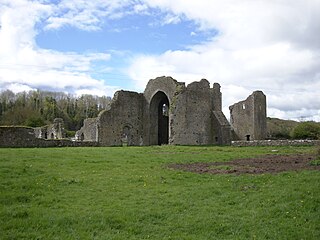
Ballybeg Priory, also known as Ballybeg Abbey, the Abbey of St Thomas, and St Thomas's Priory, is a 13th-century priory of the Augustinian order near the town of Buttevant, County Cork, Ireland. It is home to one of the best preserved and most substantial dovecots in Ireland. The priory was founded in 1229 and dissolved in 1541, the land and buildings passing into private hands. Those parts of the buildings that have escaped from the stone being removed for use in other buildings are mostly late medieval.

The Buttevant Franciscan Friary is a ruined 13th-century Franciscan friary is situated in the middle of the town of Buttevant, County Cork, Ireland. The Augustinian friary in nearby Ballybeg is often confused with the Buttevant Franciscan Friary in historical documents.
Fachtna of Rosscarbery, known also as Fachanan, was the founder of the monastery of Rosscarbery, County Cork. He died around 600.

The Augustinian Priory of St Mary, most commonly referred to as Bridgetown Priory and also as Bridgetown Abbey, is a ruined 13th-century Augustinian monastery of the Canons regular of St. Victor. It is located in Castletownroche, County Cork, Ireland near where the River Awbeg meets the Blackwater. Once an affluent monastery, it was dissolved by Henry VIII in 1541, and the ruins are currently managed by Cork County Council.

The Collegiate Church of Saint Mary the Virgin, also known as St Mary's Collegiate Church, is a large Anglican church in Youghal, east County Cork, Ireland. Dating to roughly 1220 and dedicated to the Virgin Mary, it is part of Youghal Union of Parishes, in the United Dioceses of Cork, Cloyne and Ross.
The School of Ross was a monastic institution located in what is now called Rosscarbery, County Cork, Ireland, but formerly Ross-Ailithir, from the large number of monks and students who flocked to its halls from all over Europe.
The Diocese of Ross was a separate diocese situated in south-west Ireland. Following the Reformation, there were two dioceses. In the Church of Ireland, the diocese is now part of the Diocese of Cork, Cloyne and Ross. In the Roman Catholic Church, it is part of the Diocese of Cork and Ross. In the 19th century, an exclave of the diocese existed around that part of the Beara peninsula in County Cork including the area around Glengariff though not as far east as Bantry. The main diocesan territory was centred on the towns of Baltimore, Skibbereen, Rosscarbery and Clonakilty which lie along the modern national road N71.
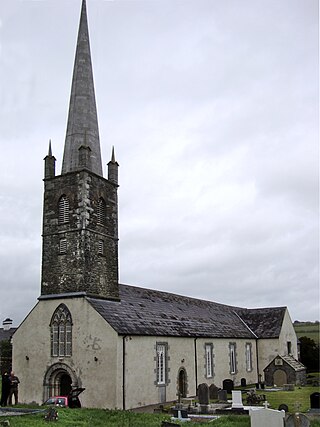
The Bishop of Ross was a separate episcopal title which took its name after the town of Rosscarbery in County Cork, Ireland. The title is now united with other bishoprics. In the Church of Ireland it is held by the Bishop of Cork, Cloyne and Ross, and in the Roman Catholic Church it is held by the Bishop of Cork and Ross.
The Bishop of Cork and Ross is an episcopal title which takes its name after the city of Cork and the County Cork town of Rosscarbery in the Republic of Ireland. The combined title was first used by the Church of Ireland from 1638 to 1660 and again from 1679 to 1835. At present the title is being used by the Roman Catholic Church.
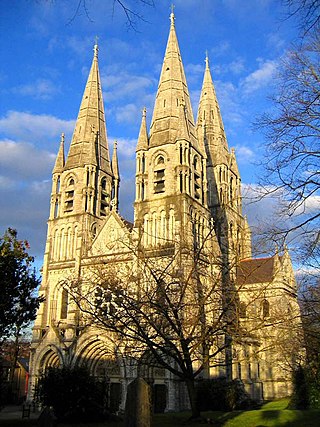
The Diocese of Cork, Cloyne and Ross, also referred to as the United Diocese of Cork, Cloyne and Ross, is a diocese in the Church of Ireland. The diocese is in the ecclesiastical province of Dublin. It is the see of the Bishop of Cork, Cloyne and Ross, the result of a combination of the bishoprics of Cork and Cloyne and Ross in 1583, the separation of Cork and Ross and Cloyne in 1660, and the re-combination of Cork and Ross and Cloyne in 1835.
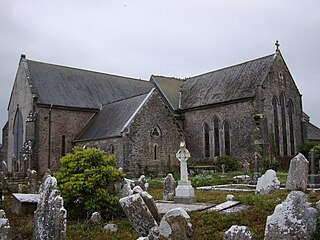
St. Colman's Cathedral, Cloyne is a cathedral of the Church of Ireland in Cloyne, County Cork in Ireland. It is in the ecclesiastical province of Dublin. Originally a Roman Catholic cathedral, it was converted to an Anglican cathedral in 1678.
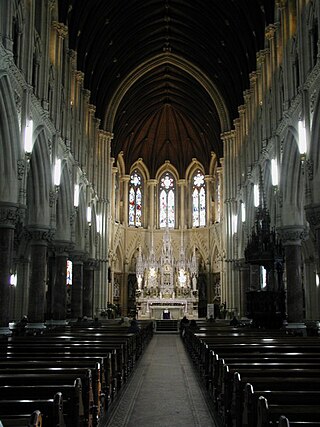
The Diocese of Cloyne is a Latin diocese of the Catholic Church in Ireland. It is one of six suffragan dioceses in the ecclesiastical province of Cashel.
The Dean of Ross is based at the Cathedral Church of St. Fachtna in Rosscarbery in the Diocese of Ross within the united bishopric of Cork, Cloyne and Ross of the Church of Ireland.

The Church of St Peter, Carrigrohane, is a Gothic Revival church in Cork, Ireland. It belongs to the Church of Ireland and was constructed in 1854, and extended by William Burges in 1865–68. The church is located on Church Hill, Carrigrohane, to the west of Cork city. It stands on the site of an earlier church, and is dedicated to Saint Peter. Along with the Church of the Resurrection and St Senan's Church it is part of the Carrigrohane Union of Parishes in the Diocese of Cork, Cloyne, and Ross.

Christ Church is a Gothic Revival Anglican church located in Innishannon, County Cork, Ireland. It was completed in 1856. It is part of the Bandon Union of Parishes, in the Diocese of Cork, Cloyne, and Ross. The building is listed on Cork County Council's Record of Protected Structures.
St Matthew's Church is a small Gothic Revival Anglican church located in Aghadown, County Cork, Ireland. It was completed in 1873. It is dedicated to Matthew the Apostle. Along with St Matthias' Church in Ballydehob, it is part of the Ballydehob Union of Parishes in the Diocese of Cork, Cloyne, and Ross.














